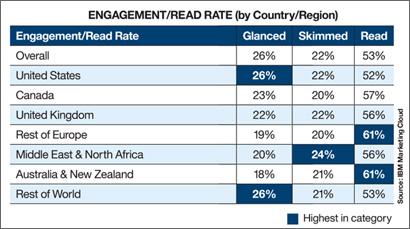Mobile devices are complicating our usual understanding of email metrics.
Just as marketers newer to email have grasped the nuances of deliverability, inbox placement, the differences
between click-through and click-to-open rates and unique versus gross clicks and opens, along comes mobile with its own measurement challenges.
Two metrics that have been around for several
years explore the impact mobile email is having:
- Device/email client usage, which compares differences in the percentages of people using Web-based, mobile and desktop-based
email clients to read email.
- Engagement rate, which reflects the time recipients engage with email messages.
Once considered "nice to have" metrics, these
are rapidly becoming must-haves because they reveal more about your subscribers and how they're interacting with your email -- information you can incorporate in your email content, design and layout
to reflect changes in your subscriber population.
advertisement
advertisement
They also give you a potential competitive advantage over other marketers who aren't tracking, analyzing, learning and making changes based on
this data.
Engagement rates worldwide
The chart below from our recent email marketing benchmark report breaks down the percentage differences in engagement rates, with times
defined as "read" (read eight seconds or more); "skimmed" (read two seconds to less than eight) and "Glanced/deleted" (less than two seconds).

What the engagement rate does (and doesn't) tell us
Because engagement rate is a process metric, we have to be careful about extrapolating whether higher engagement rates translate
into more click-throughs, conversions and revenue.
But it raises some issues worth pursuing. The "glanced" rate, for example, might appear to be a negative. Doesn't everybody want
emails to be read (eight seconds or more)?
This underscores email marketing's key role in your branding strategy. A message with your strongly branded "from" name and consistently high-quality
subject line keeps your name, brand and value proposition in front of your customers until they're ready to buy.
Looking at the chart above, roughly one in five of your messages (22%) gets at
least a cursory look. The 26% that rated just a glance weren't necessarily failures. They underperformed on one level, but helped build your brand on another.
This underscores a basic email
marketing practice. If you have an open rate of 20%, and 25% or so of those opened messages get just a glance, in essence 85% of your messages are either not opened, looked at for less than two
seconds, or deleted immediately.
As such, you must double down on subject lines, pre-header text and "from" names, so that they deliver branding value that won't come from the body of the
email message.
Writing your subject lines to work for non-openers as well as openers could be another way of thinking differently about email, which I called "random messiness" in an earlier Email Insider.
Next steps in
understanding engagement rate
Although I can't say definitively how read times correlate with conversions, my friends over at email-marketing agency Alchemy Worx did find a correlation
with click-to-open rate (CTOR) after analyzing one B2C client's metrics.
For this brand, the CTOR was roughly double for recipients who "read" the email versus those categorized as "skimmed"
or "glanced." The results suggest that email subscribers who spend more time with your email are more likely to click and then possibly to convert.
Yes, this conclusion is obvious. But, I
don't know of any current research on this topic now that mobile devices are so prevalent. As marketers design their emails to be mobile-friendly, using fewer calls to action, less text and more
visuals, the key research question becomes this:
Is less than eight seconds enough time for an email recipient to consume email content, process it and then make a decision to click through
to your Web site?
I don’t have an answer to this question yet, but hope to explore this topic in future columns.
Until next time, take it up a notch.